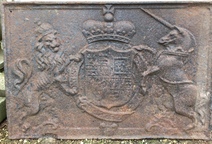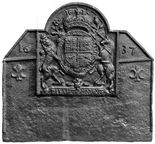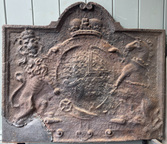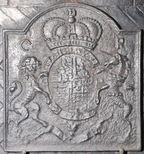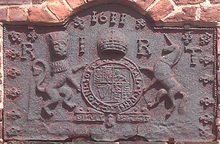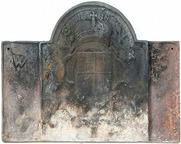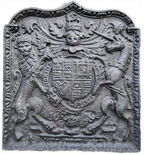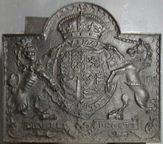-
487
Description: Rectangular; cavetto-moulded edging; shield, garter, supporters and crown of the English royal house of Stuart.
Notes: One of many designs of the Stuart royal arms on firebacks. Another, corroded version of this fireback measures 900mm x 610mm. Criterion Auctions, Bath, 10 Sep 2016 lot 168.
Copies of this fireback are known.
Inscription: HONY SOIT QUI MAL Y PENSE
Arms: English Stuart royal
- Decoration tags:
- rectangular (shape)
- cavetto (edging)
- whole carved pattern
- armorial
- royal
Manufactured: in the mid- to late-17th century in England.
Current location: not known.
- Attached to series:
- Stuart royal armorial firebacks
-
955
Description: Composite; canted arched rectangular shape; armorial fireback, cavetto edging, with Stuart Royal arms, garter, supporters, crown and motto, and 1620 date above crown; this overlies a canted rectangular plate, with twisted rope edging, fillet; two quasi-horizontal fillets from the tops of the vertical sides to the middle of the armorial fireback separate the back into two uneven parts, the date in the top part, split by the armorial, and a fleur-de-lys at the top of the lower part, also separated by the armorial.
Notes: The use of the armorial back is seen frequently and probably dates from 1619, though the date is usually altered; in this case the alteration does not match the more prominent date for the fireback; photograph ex T. Crowther & Son Ltd, 1985.
Inscription: 16 29 / HONI SOIT QUI MAL Y PENSE / 16 37 / DIEV ET MON DROIT
Arms: English Stuart royal
- Decoration tags:
- rectangular with canted top corners and round arch (shape)
- rope (edging)
- carved stamps
- whole carved pattern
- composite
- individual numbers
- heraldic
- armorial
- royal
- text
Manufactured: in 1637 possibly in the Forest of Dean area of England.
Current location: not known.
-
1312
Description: Arched rectangular shape with small rhomboidal flanges in the corners of the arch, the top of the arch comprising two opposing loops; cavetto moulded edging; crowned circular shield within a Garter of the Stuart royal arms of England with crowned lion and unicorn supporters.
Notes: One of several variations of the arms of the Stuart royal dynasty on firebacks. Duke's auctioneers, Dorchester, Dorset, 10 Jun 2025, lot 9.
Copies of this fireback are known.
Inscription: [Garter and royal mottoes illegible]
Arms: English Stuart royal
- Decoration tags:
- rectangular with round arch (shape)
- cavetto (edging)
- whole carved pattern
- heraldic
- armorial
- royal
Manufactured: in the mid- to late-17th century in England.
Current location: not known.
- Attached to series:
- Stuart royal armorial firebacks
-
56
Description: Flattened arched rectangular shape; cavetto moulded edge all round; Stuart royal arms with lion and unicorn supporters, crown, garter and motto; CR initials placed separately outside supporters; date split either side of crown.
Notes: A much-copied variant with the additional initials, I T, above the date and on either side of the crown.
Copies of this fireback are known.
Inscription: I T / 1635 / C R / HONI SOIT QVI MAL Y PENSE / DIEV ET MON DROIT
Arms: English Stuart royal (Charles I )
- Decoration tags:
- rectangular with round arch (shape)
- cavetto (edging)
- whole carved pattern
- planklines
- armorial
- royal
- text
Manufactured: in 1635 in the Weald area of England.
Current location: Dyrham Park, Dyrham, Gloucestershire, England.
Museum number: 453291 (part of the National Trust museum group)
Citation: Lloyd, N., 1925, 'Domestic Ironwork I', Architectural Review, 58, pp. 58-67.
- Attached to series:
- Carolean royal armorial firebacks
- Stuart royal armorial firebacks
-
282
Description: Arched rectangle; cavetto moulded edging; garter enclosing Stuart royal arms, crown, crowned lion and unicorn supporters and motto; initials in top corners.
Notes: The crown is not typically English in form, suggesting that the patternmaker may have been of foreign extraction. Inferior copies of this fireback were advertised in Kings Worthy Foundry's (Winchester) catalogue in the mid-20th century.
Copies of this fireback are known.
Inscription: C R / [Garter motto - illeg.]
Arms: English Stuart royal
- Decoration tags:
- rectangular with round arch (shape)
- cavetto (edging)
- whole carved pattern
- armorial
- royal
- text
Manufactured: in the mid- to late-17th century in England.
Current location: Chequers, Ellesborough, Buckinghamshire, England.
-
967
Description: Arched rectangular shape; twisted rope edging; central shield, garter, supporters, motto and crown; date in arch; initials 'I R' (Iacobus Rex) separated by crown; initials 'R T' separated by supporters, and level with other initials; fleur-de-lys stamp repeated 16 times, one each side of date, two on each shoulder of plate, five down each side.
Notes: A naively carved armorial of James I. The initials 'RT' are likely to be those of the person who commissioned the fireback. A fireback with an identical armorial, supporters and royal initials, dated 1633, was recorded by Alfred Watkins at Fawley Court, Brockhampton, Herefordshire, before 1918 (but now no longer in situ).
Inscription: 1611 / R I R T / HONY SOIT QVI MAL Y PENSE / [motto illegible]
Arms: English Stuart royal
- Decoration tags:
- rectangular with round arch (shape)
- rope (edging)
- whole carved pattern
- individual letters
- individual numbers
- heraldic
- armorial
- text
Manufactured: in 1611 in England.
Current location: 48 Scotland Street, Ellesmere, Shropshire, England.
- Attached to series:
- Stuart royal armorial firebacks
-
1281
Description: Composite; arched rectangular shaped, armorial fireback, cavetto edging, with Stuart Royal arms, garter, supporters, crown and motto, and 1639 date above crown; this overlies a rectangular plate with fillet edging; top centre in the space each side of the central shield, an initial letter - W to left, C to right.
Notes: One of several variants using a fireback with the English Stuart royal arms, the date probably altered according to when it was cast. The original date of the fireback was probably 1619. Garth's Auctioneers, Columbus, OH, 3 Jan 2015, lot 2347 ($300).
Inscription: 1639 / W C
Arms: English Stuart royal
- Decoration tags:
- rectangular with round arch (shape)
- fillet (edging)
- carved stamps
- whole carved pattern
- composite
- extension panels
- heraldic
- armorial
- royal
- text
Manufactured: in 1639 possibly in the Forest of Dean area of England.
Current location: not known.
-
1062
Description: Rectangular with ogee arch; ovolo, egg and dart edging; shield, garter, helm, mantling, crest and motto of the English House of Stuart; date split either side of garter buckle.
Notes: One of several firebacks, all of the same date, but varying in size, framing style and moulding; all have stylistic features in common and will have been the work of the same pattern maker, who was also responsible for carving royal coats of arms in three West Country churches. Similar in design but proportionately different to no. 880.
Copies of this fireback are known.
Inscription: HONI SOIT QVI MAL Y PENSE / 16 18
Arms: English Stuart royal (James I)
- Decoration tags:
- rectangular with ogee-arch (shape)
- ovolo, egg and dart (edging)
- whole carved pattern
- heraldic
- armorial
- text
Manufactured: in 1618 possibly in the Forest of Dean area of England.
Current location: not known.
-
1292
Description: Arched rectangular shape; Greek Key border with fillet edges; in high relief, in front of swagged drapery, the shield of, quarterly, France quartering England, Scotland and Ireland, surrounded by a Garter, and surmounted by a ducal coronet; below, the inscription in capitals.
Notes: The use of the Greek Key design as a border is believed to be unique for an English fireback. Although somewhat indistinct, the use of the Stuart royal arms and the ducal coronet can be explained by the fact that the fireback was one of a group cast for the 2nd Duke of Richmond, whose father, the 1st duke, was the illegitimate son of Charles II and Louise de Kéroualle. The Richmond arms were differenced from the Stuart royal arms by the addition of a bordure compony (the detail of which is not distinct on this casting). Sowley Furnace, near Beaulieu in Hampshire, was owned in 1732 by John, 2nd Duke of Montagu, and was let to Miles Troughton. An identical fireback also at Goodwood is dated 1731 and a similar, but smaller, variant of this fireback, is dated 1732.
Copies of this fireback are known.
Inscription: HONI SOIT QUI MAL Y PENSE / SOWLEY MDCCXXX
Arms: Duke of Richmond
- Decoration tags:
- rectangular with round arch (shape)
- fillet (edging)
- whole carved pattern
- heraldic
- armorial
- royal
- text
Manufactured: in 1730 at Sowley Furnace, Beaulieu in the New Forest area of England.
Current location: Goodwood House, Westhampnett, West Sussex, England.
-
1018
Description: Arched rectangular; cavetto-moulded edging, invected on the inner edge; English royal Stuart shield, garter, crown, supporters and motto; monogram to right of unicorn supporter.
Notes: The monogram probably identifies the pattern-maker, whose invected edging seems to be a distinctive style.
Copies of this fireback are known.
Inscription: HONI SOIT QUI MAL Y PENSE / RN / DIEV ET MON DROIT
Arms: English Stuart royal
- Decoration tags:
- rectangular with round arch (shape)
- cavetto (edging)
- whole carved pattern
- monogram
- armorial
- royal
- text
Manufactured: in the early- to mid-17th century in England.
Current location: National Maritime Museum, Greenwich, London, England.
Museum number: AAA3476 (part of the National Maritime Museum museum group)
- Attached to series:
- RN series
- Stuart royal armorial firebacks
